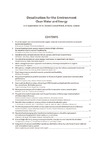Identificador persistente para citar o vincular este elemento:
https://accedacris.ulpgc.es/jspui/handle/10553/106210
| Campo DC | Valor | idioma |
|---|---|---|
| dc.contributor.author | Brito Espino, Saulo Manuel | en_US |
| dc.contributor.author | Mendieta Pino, Carlos Alberto | en_US |
| dc.contributor.author | Pérez Báez, Sebastián Ovidio | en_US |
| dc.contributor.author | Ramos Martín, Alejandro | en_US |
| dc.date.accessioned | 2021-03-24T13:50:04Z | - |
| dc.date.available | 2021-03-24T13:50:04Z | - |
| dc.date.issued | 2018 | en_US |
| dc.identifier.uri | https://accedacris.ulpgc.es/handle/10553/106210 | - |
| dc.description.abstract | Nowadays, the increase in production and concentration of intensive livestock operation throughout the years all around the world, together with mismanagements of livestock manure, have raised the risk of contamination to the environment. The increasingly strict environmental regulation has created the need to find several solutions which combine low-cost facilities and resource efficiency in wastewater treatment. Constructed wetlands (CWs) are now more widely applied than other technologies as an alternative of conventional methods. Several models of biochemical reaction in CWs have been developed over the last 60 years, however the great majority of authors agree that it is necessary to approach with more in-depth understanding processes in these treatment systems. The main objective of this work has been to develop a computational fluid dynamic (CFD) Model to describe anaerobic digestion, that regularly occurs into the CWs in order to simulate the complex physicochemical and biochemical processes, offering higher spatial resolutions and different reaction rates, and considering simultaneous processes. The method involves, simultaneously, dynamics characteristics of fluids with kinetic growth based on the IWA Anaerobic Digestion Model Nº1 (ADM1). A mathematical model was developed based on mass balance for each system component, resulting 18 non-lineal system for second-order elliptic equations. On the other hand, a generalized Stokes variational formulation was implemented to describe the hydraulic performance. Finite element method (FEM) was applied to solve the equations subjetcted to Dirichlet and Neumann boundary conditions. To validate the method, simulations implemented with FreeFem++ are presented. The obtained result offers dynamic behaviour of the model solutions for the microbial and the substrate in CWs, for each one of the phase of the biological processes. The performance will depend on the boundary condition. The result indicates that the model was be able to simulate, with good accuracy, substrate, microorganism, pH and total volatile fatty acids (TVFA) concentrations inside the system. The conclusion was that the model was successfully implemented to simulate biochemical and physicochemical processes in CWs. This original method of simulation which has been applied to CWs allows develop different design including boundary onditions. Plans for the future will be to develop 3D model and to validate the results with experimental models. | en_US |
| dc.language | eng | en_US |
| dc.publisher | EDS | en_US |
| dc.subject | 3308 Ingeniería y tecnología del medio ambiente | en_US |
| dc.subject | 330810 Tecnología de aguas residuales | en_US |
| dc.subject | 3104 Producción Animal | en_US |
| dc.subject.other | Constructed wetland | en_US |
| dc.subject.other | Water quality | en_US |
| dc.subject.other | Anaerobic digestion | en_US |
| dc.subject.other | ADM1 | en_US |
| dc.subject.other | Numerical simulation | en_US |
| dc.subject.other | Finite element method | en_US |
| dc.title | Application of a model-based method for hydrodynamic processes in constructed wetland to management of livestock wastewater based on finite element method | en_US |
| dc.type | info:eu-repo/semantics/conferenceobject | en_US |
| dc.type | ConferenceObject | en_US |
| dc.relation.conference | Desalination for the Environment: Clean Water and Energy. Greece 2018 | en_US |
| dc.description.firstpage | 105 | en_US |
| dc.investigacion | Ingeniería y Arquitectura | en_US |
| dc.investigacion | Ciencias | en_US |
| dc.type2 | Actas de congresos | en_US |
| dc.utils.revision | Sí | en_US |
| dc.date.coverdate | 3–6 September 2018 | en_US |
| dc.identifier.ulpgc | Sí | en_US |
| dc.contributor.buulpgc | BU-ING | en_US |
| item.fulltext | Con texto completo | - |
| item.grantfulltext | open | - |
| crisitem.author.dept | GIR IUNAT: Control analítico de fuentes medioambientales | - |
| crisitem.author.dept | IU de Estudios Ambientales y Recursos Naturales | - |
| crisitem.author.dept | GIR IUNAT: Control analítico de fuentes medioambientales | - |
| crisitem.author.dept | IU de Estudios Ambientales y Recursos Naturales | - |
| crisitem.author.dept | Departamento de Ingeniería de Procesos | - |
| crisitem.author.dept | GIR IUNAT: Control analítico de fuentes medioambientales | - |
| crisitem.author.dept | IU de Estudios Ambientales y Recursos Naturales | - |
| crisitem.author.dept | GIR SIANI: Computación Evolutiva y Aplicaciones | - |
| crisitem.author.dept | IU Sistemas Inteligentes y Aplicaciones Numéricas | - |
| crisitem.author.dept | Departamento de Ingeniería de Procesos | - |
| crisitem.author.orcid | 0000-0001-6108-6774 | - |
| crisitem.author.orcid | 0000-0002-1808-0112 | - |
| crisitem.author.orcid | 0000-0002-6909-0759 | - |
| crisitem.author.orcid | 0000-0001-5759-4469 | - |
| crisitem.author.parentorg | IU de Estudios Ambientales y Recursos Naturales | - |
| crisitem.author.parentorg | IU de Estudios Ambientales y Recursos Naturales | - |
| crisitem.author.parentorg | IU de Estudios Ambientales y Recursos Naturales | - |
| crisitem.author.parentorg | IU Sistemas Inteligentes y Aplicaciones Numéricas | - |
| crisitem.author.fullName | Brito Espino, Saulo Manuel | - |
| crisitem.author.fullName | Mendieta Pino, Carlos Alberto | - |
| crisitem.author.fullName | Pérez Báez,Sebastián Ovidio | - |
| crisitem.author.fullName | Ramos Martín, Alejandro | - |
| Colección: | Actas de congresos | |
Visitas
294
actualizado el 16-jun-2024
Descargas
210
actualizado el 16-jun-2024
Google ScholarTM
Verifica
Comparte
Exporta metadatos
Los elementos en ULPGC accedaCRIS están protegidos por derechos de autor con todos los derechos reservados, a menos que se indique lo contrario.
